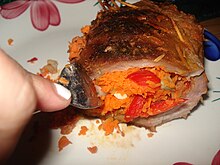Matambre

Matambre is the name of a very thin cut of beef in Argentina, Uruguay and also Paraguay. It is a rose colored muscle taken between the skin and the ribs of the steer,[1] a sort of flank steak. It is not the cut known normally in the U.S. as flank steak. Some people refer to it as the "fly shaker", because it is the muscle used by the animal to twitch to repel flies and other flying insects.
Overview

The same word (or matambre arrollado[2] or matambre relleno) is also used for a dish made of a matambre meat roll stuffed[1] with vegetables, peppers, ham, hard-boiled eggs and herbs, then boiled or oven-roasted. It is served sliced—with the fillings making a colourful display—either hot or cold. It is often eaten with chimichurri sauce. It is a rather fatty meat and is usually eaten with vegetables. Pork matambre is also used.
The name matambre is formed from the combination of "matar" and "hambre"[1] ("hunger killer").
Cut
Matambre is cut from the side of the cow, between the skin and the ribs. The scientific name for the muscle is cutaneous trunci. It is a thin rose colored muscle, also known in packing houses as "fly shaker" or "elephant ear". It is also known as the "twitch" muscle because the animal makes it twitch or tremble to repel flying insects like flies. It is very thin and lends itself for rolling up with different stuffings.
Argentine variations
In Argentina, the matambre is sometimes served as a steak, but this is not the typical serving method. The more common method is known as "matambre arrollado" (stuffed, or filled matambre). The ingredients for this dish vary from province to province, but most common include whole carrots, hard-boiled eggs, and plenty of black pepper. These ingredients are then rolled up inside of the matambre sheet and sewn or pinned together to keep the rolled matambre from coming unrolled. It is then boiled in milk, or sometimes water, and roasted in the oven. After it is removed from the oven and cooled, it is sliced into thin pieces of lunch meat and served in toasted French roll with mayonnaise, and sometimes Argentine chimichurri, as a condiment. In Uruguay, and to a lesser extent in Argentina, matambre is marinated in milk, baked flat in the oven, and covered with the marinade, with the addition of lightly beaten eggs and cheese at the end of the cooking period. It is called "matambre a la leche" (matambre in milk). Another method of serving matambre is "matambre a la pizza" which is prepared in a similar way but instead of being rolled it is topped with pizza ingredients like tomato sauce and mozzarella.[3]
Asado
This is the most traditional and archaic way of consuming it in Rio de la Plata.[4] Its use dates back to the cow herds of colonial times, when gauchos used only the soft parts of the prey of cimarrona cows because of their easy availability. Given the primitive tools (no more than a "fasona") and, on the other hand, the abundance of these cattle, which did not merit more widespread use, what was not matambre and offal was practically left to rot in times before the tasajo trade.
The traditional way of grilling in the countryside has always been crosscut and the highest quality cut was matambre, until modernization brought new tools that allowed the ribs to be sawn, which in turn allowed the invention of a cut called asado, which displaced matambre to last place due to its hardness and low quality. Asado, which means grill in English, is also known in Argentina as "Parilla" (pronounced parisha), which also means barbecue or grill.[5][6][7]
However, this traditional way of using matambre still survives in some parts of Argentina, such as in Chascomús, where it is known as "matambre adobado". Marinated matambre is grilled using a marinade and flavored with lemon juice.
A more modern version of this marinade is perhaps the "matambre a la pizza", common in Argentina and Uruguay, which combines the concepts of "grilled matambre" and "pizza".[8][9] To prepare the latter, a topping of tomatoes, seasonings and cheese is placed on the part that has no fat.
See also
References
- ^ a b c "Dictionary: matambre" (in Spanish). Real Academia Española. Retrieved 2019-03-26.
- ^ "Matambre arrollado" (in Spanish). clarin.com. Retrieved 2019-03-26.
- ^ "Ingredientes para preparar Matambre a la pizza" (in Spanish). SitiosArgentina.com.ar. Retrieved 2019-03-26.
- ^ "Argentinian Asado: history, info, interesting facts". webfoodculture.com. Retrieved 2023-11-12.
- ^ "The asado, the star of Argentinian gastronomy". arecotradicion.com. Retrieved 2023-11-12.
- ^ "How To Grill An Argentinean Asado: 2023 Guide!". argentineasado.com. Retrieved 2023-11-12.
- ^ "Everything You Need To Know About Asados in Argentina". matadornetwork.com. Retrieved 2023-11-12.
- ^ "It's What's Inside That Counts: the History and Secrets of Matambre". artsandculture.google.com. Retrieved 2023-11-12.
- ^ "Matambre a la pizza". www.tasteatlas.com. Retrieved 2023-11-12.
Further reading
- Aeberhard, Danny; Benson, Andrew; Phillips, Lucy; O'Brien, Rosalba (2000). The Rough Guide to Argentina. Rough Guides. ISBN 9781843538448.
